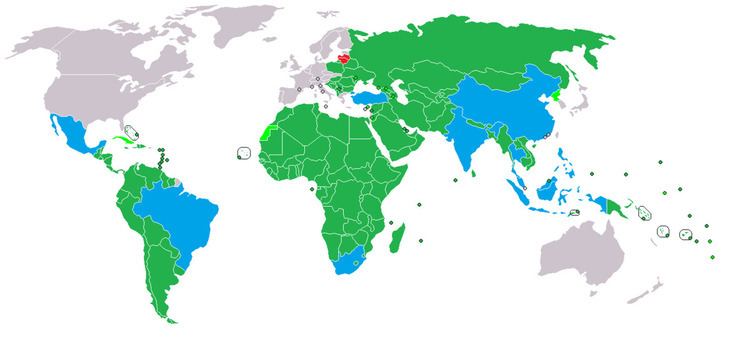 | ||
The category of newly industrialized country (NIC) is a socioeconomic classification applied to several countries around the world by political scientists and economists.
Contents
NICs are countries whose economies have not yet reached a developed country's status but have, in a macroeconomic sense, outpaced their developing counterparts. Another characterization of NICs is that of countries undergoing rapid economic growth (usually export-oriented). Incipient or ongoing industrialization is an important indicator of an NIC. In many NICs, social upheaval can occur as primarily rural, or agricultural, populations migrate to the cities, where the growth of manufacturing concerns and factories can draw many thousands of laborers.
NICs usually share some other common features, including:
Historical context
The term came into use around 1970, when the Four Asian Tigers of Hong Kong, Singapore, South Korea, and Taiwan rose to global prominence as NICs in the 1970s and 1980s, with exceptionally fast industrial growth since the 1960s; all four economies have since graduated into advanced economies and high-income economies. There is a clear distinction between these countries and the countries now considered NICs. In particular, the combination of an open political process, high GNI per capita, and a thriving, export-oriented economic policy has shown that these countries have now not only reached but surpassed the ranks of many developed countries.
All four economies are classified as high-income economies by the World Bank and Advanced economies by the International Monetary Fund (IMF) and U.S. Central Intelligence Agency (CIA). All of them, like Western European countries, possess Human Development Index considered "very high" by the UN.
Current NICs
The table below presents the list of countries consistently considered NICs by different authors and experts. Turkey and South Africa are classified as developed countries by the CIA. Turkey was a founding member of the OECD in 1961 and Mexico joined in 1994. The G8+5 group is composed of the original G8 members in addition to China, India, Mexico, South Africa and Brazil.
Note: Green-colored cells indicate higher value or best performance in index, while yellow-colored cells indicate the opposite.
For China and India, the immense population of these two countries (each with over 1.2 billion people as of September 2015) means that per capita income will remain low even if either economy surpasses that of the United States in overall GDP. When GDP per capita is calculated according to purchasing power parity (PPP), this takes into account the lower costs of living in each newly industrialized country. GDP per capita typically is an indicator for living standards in a given country as well.
Brazil, China, India, Mexico and South Africa meet annually with the G8 countries to discuss financial topics and climate change, due to their economic importance in today's global market and environmental impact, in a group known as G8+5. This group is expected to expand to G14 by adding Egypt alongside the five forementioned countries.
Other NICs
Authors set lists of countries accordingly to different methods of economic analysis. Sometimes a work ascribes NIC status to a country that other authors don't consider NIC. This is the case of countries such as Argentina, Chile, Egypt, Sri Lanka and Russia.
Criticisms of NICs
NICs usually benefit from comparatively low wage costs, which translates into lower input prices for suppliers. As a result, it is often easier for producers in NICs to outperform and outproduce factories in developed countries, where the cost of living is higher, and trade unions and other organizations have more political sway.
This comparative advantage is often criticized by advocates of the fair trade movement.
Critics of NICs argue economic freedom is not always associated with political freedom in countries such as China, pointing out that Internet censorship and human rights violations are common.[16] The case is diametrically opposite for India; While being a liberal democracy throughout after its independence, India has been widely criticized for its inefficient, bureaucratic governance and slow process of structural reform. Thus, while political freedom in China remains limited, the average Chinese citizen enjoys a higher standard of living than his or her counterpart in some regions of India.[17]
Problems NICs Face
Meanwhile, South Africa faces an influx of immigrants from countries such as Zimbabwe, although many also come from Burundi, Democratic Republic of the Congo, Rwanda, Eritrea, Ethiopia and Somalia. While South Africa is considered wealthy on a wealth-per-capita basis, economic inequality is persistent and extreme poverty remains high in the region.
Mexico's economic growth is hampered in some areas by an ongoing drug war in the north of the country.
Meanwhile, other NICs face common problems such as widespread corruption and/or political instability as well as other circumstances that cause them to face the "middle income trap".
